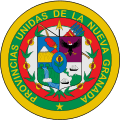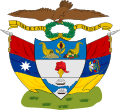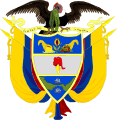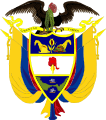Coat of arms of Colombia
The coat of arms of Colombia contains a shield with numerous symbols. Perched on top of the shield is an Andean condor holding an olive crown and the condor symbolizing freedom. The national motto, Libertad y Orden (Spanish for Liberty and Order), is on a scroll in between the bird and the shield in black font over golden background. The condor is depicted as displayed (with his wings extended) and looking to the right.
| Coat of arms of Colombia | |
|---|---|
 | |
| Armiger | Republic of Colombia |
| Adopted | 1924 |
| Crest | Andean condor proper with wings inverted displayed, facing dexter with an olive branch on bill, a ribbon in base |
| Blazon | Tierced per fess Azure, Argent and Azure, in centre chief a Pomegranate between in sinister chief a Cornucopia overflowing with coins and in dexter chief a cornucopia overflowing with fruits and vegetables proper, in center point a Phrygian cap Gules held on a Lance proper, in base the Isthmus of Panama Vert fesswise between two Ships Sable, sailed Argent. |
| Supporters | Flags of Colombia |
| Motto | Libertad y Orden "Liberty and Order" |
Description
The national flag is draped on each side of the shield. The shield is broken into three portions. In the lowermost portion is a depiction of ships, pointing to the maritime history of Colombia, mainly to the Isthmus of Panama, which was part of Colombia until 1903. Nowadays represents the two oceans that border the country (Atlantic and Pacific). The sails mean the Colombian commerce with the rest of the world and the rising economy. In the middle section, over a field of silver (argent), the Phrygian cap is presented; this being a traditional symbol of liberty and freedom. The topmost section contains a pomegranate over a blue (azure) field, as a symbol of the Vice royalty of New Granada (early colonial name of Colombia back in the 18th century), in the middle flanked by two cornucopias or horns of plenty: the one at the right with golden and silver coins and the one at the left with tropical fruits. This portion represents the agricultural and mineral wealth of Colombian soil.
The coat of arms of the Republic was designed by Francisco de Paula Santander, and was adopted via Act 3 of May 9, 1834, with later non-essential modifications according to Ordinance 861 of 1924.
Gallery
National coat of arms
 Heraldic coat of arms of Colombia
Heraldic coat of arms of Colombia Regulated coat of arms of Colombia
Regulated coat of arms of Colombia.svg.png) Common coat of arms in use
Common coat of arms in use
Historical coats of arms
 Coat of Viceroyalty of New Granada (1717-1819)
Coat of Viceroyalty of New Granada (1717-1819).svg.png) Coat of United Provinces of New Granada (1814) (provisional)
Coat of United Provinces of New Granada (1814) (provisional) Coat of United Provinces of New Granada (1814-1816)
Coat of United Provinces of New Granada (1814-1816).svg.png) Coat of the Gran Colombia (1819)
Coat of the Gran Colombia (1819).svg.png) Coat of the Gran Colombia (1820)
Coat of the Gran Colombia (1820).svg.png) Coat of the Gran Colombia (1821-1830)
Coat of the Gran Colombia (1821-1830).png) Coat of the Gran Colombia (proposal)
Coat of the Gran Colombia (proposal).svg.png) Coat of the State of New Granada (1830-1834)
Coat of the State of New Granada (1830-1834).svg.png) Coat of Republic of New Granada (1833) (proposal)
Coat of Republic of New Granada (1833) (proposal) Coat of Republic of New Granada (1834-1858)
Coat of Republic of New Granada (1834-1858).svg.png) Coat of Republic of New Granada (1854) (provisional)
Coat of Republic of New Granada (1854) (provisional).svg.png) Coat of Republic of New Granada (1854) (provisional)
Coat of Republic of New Granada (1854) (provisional) Coat of Granadine Confederation (1858-1861)
Coat of Granadine Confederation (1858-1861) Coat of United States of Colombia (1861-1886)
Coat of United States of Colombia (1861-1886).svg.png) Coat of Republic of Colombia (1886-1924)
Coat of Republic of Colombia (1886-1924) Coat of Republic of Colombia (1924-present)
Coat of Republic of Colombia (1924-present)
Other versions
Criticism
Some critics have argued that the coat of arms is outdated and anachronistic, as the Andean condor is a very threatened species in the country, with barely 100 creatures soaring the landscape. It has also been discussed that the condor is still a vulture and feeds of carrion, making it an animal with a low profile that never hunts its own food. In addition, the Andean condor is also the national bird of Ecuador, Bolivia and Chile. The pomegranate, being a Mediterranean fruit, is not currently cultivated in Colombia and the Phrygian cap is of Greek origin. The Isthmus of Panama, no longer belonging to Colombia, has also been suggested as an element needing changing.
Bibliography
- Ortega Ricaurte, Enrique (1954). Heráldica Nacional (in Spanish). Banco de la República, Bogotá. OCLC 253691402.
- García, Júlio Cesar (2000). Himnos y Símbolos de Nuestra Colombia (in Spanish). Camer Editores, Bogotá. ISBN 958-33-1489-7.
- Castrillón M., Aurelio (1961). Historial de las Banderas y Escudos Nacionales (in Spanish). Revista de las Fuerzas Armadas de Colombia, Bogotá. OCLC 39268995.
- Instituto Geográfico Agustín Codazzi - Ministerio de Hacienda y Crédito Público (1989). Atlas Básico de Colombia (in Spanish). División de Difusión Geográfica, Bogotá. No exist ISBN.
External links
| Wikimedia Commons has media related to Coats of arms of Colombia. |
| Wikisource has original text related to this article: |
- Law 12 of 1984 by which the national symbols of the Republic of Colombia are adopted. National Television Commission.
- National Symbols of Colombia. National Emblem - Coat of Arms.
- National Symbols. Agustín Codazzi Geographic Institute.
- National Symbols of Colombia. Luis Ángel Arango Library.
- National symbols of Colombia. Consulate General of Colombia.


